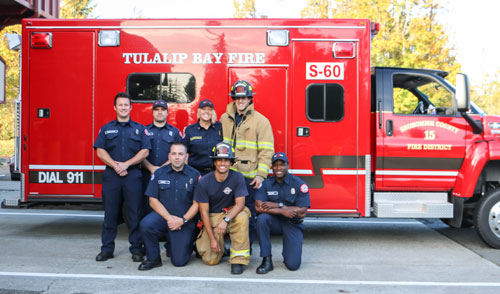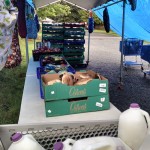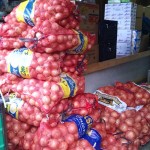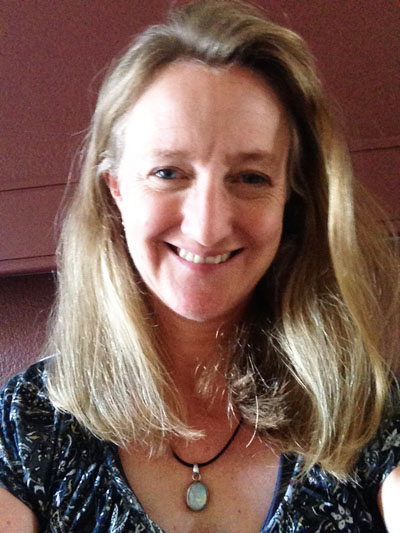Twenty-five minutes after Friday’s shooting at Marysville-Pilchuck High School, two air ambulances hovered near the campus, prepared to transport the critically wounded to the region’s highest-rated trauma hospital.

After the Marysville-Pilchuck High School shooting, an empty Airlift NW helicopter leaves Providence Regional Medical Center in Everett at 12:30 p.m. But at 1:35 p.m. the crew was called back to transport one of the victims to Harborview.
By Jennifer Sullivan and Lewis Kamb, Seattle Times
Twenty-five minutes after Friday’s shooting at Marysville-Pilchuck High School, two air ambulances hovered near the campus, prepared to transport the critically wounded to the region’s highest-rated trauma hospital.
But Snohomish County emergency medical officials canceled the Airlift Northwest choppers before they could carry patients to Seattle’s Harborview Medical Center.
Instead, four wounded students were taken by ground ambulance to Providence Regional Medical Center in Everett — geographically closer than Harborview, but less equipped to handle critical trauma cases, particularly involving juvenile or pediatric victims.
Now, some wonder at the decision.
“We were ready,” said Dr. Eileen Bulger, chief of trauma at Harborview Medical Center. “We were very ready. We had operating rooms available.”
Neurosurgeons and pediatric intensivists were on standby at Harborview, the only Level 1 adult and pediatric trauma center in the state.
Providence is rated as a Level 2 trauma center for adults, but has a Level 3 rating for patients under the age of 18, according to the state Department of Health.
It wasn’t until 2:45 p.m. — more than four hours after the shooting — that a wounded boy flown by Airlift Northwest landed at Harborview. A second boy was taken to the Seattle hospital by ground ambulance.
Bulger has contacted a colleague at Providence, requesting a debriefingin the next week or two on why the decision was made to transport all the patients to the Everett hospital.
“There were many people who expressed some concern about the transport of the patients and where they should go,” Bulger told The Seattle Times on Monday. “I’m awaiting more information before I can express a concern.”
Five students were shot by 15-year-old freshman Jaylen Fryberg.
Zoe Galasso, 15, died at the school from a gunshot wound to the head, the Snohomish County Medical Examiner’s Office said Monday. A second girl, Gia Soriano, 14, died Sunday night at Providence.
Three remain hospitalized.
Dr. Joanne Roberts, Providence Regional Medical Center’s chief medical officer, said Monday that she doesn’t know what happened at the shooting scene that resulted in the victims being taken first to Providence.
“I wasn’t part of the decision-making at the scene at all,” she said. “What I understood is that decision-making was the call of the on-scene EMS (emergency medical services) manager.”
Dr. Eric Cooper, a Providence Medical Center emergency-room physician, is also medical program director for Snohomish County Emergency Medical Services. In that role, he declined to comment on why the Airlift Northwest helicopters were not used.
“Sure, I can understand the question,” said Cooper, adding that the information “would need to come out of our public information officer.”
Cooper oversees overall emergency medical services’ (EMS) operations and response among multiple jurisdictions across the county.
Cooper said an information officer would respond with answers to The Times’ questions Monday afternoon, but none did.
Airlift Northwest’s Executive Director Chris Martin said two helicopters were sent to Marysville-Pilchuck at 10:44 a.m., minutes after the shootings, at the request of SNOPAC 911, Snohomish County’s 911 system.
Harborview is owned by King County but is managed by the University of Washington and is a part of UW Medicine. Airlift Northwest is a nonprofit managed by UW Medicine.
Both helicopters, one dispatched from Bellingham and the other from Seattle, were turned back by SNOPAC 911, Snohomish County’s 911 system, Martin said.
Between the first helicopter request, made by SNOPAC at 10:44 a.m., and 2:45 p.m., when one helicopter finally delivered one of the teens to Harborview, Airlift Northwest made four flights in response to calls for help for the shooting victims.
Two flights were turned away near Marysville-Pilchuck High School, and the third flight was turned away after being called to Providence Everett, Martin said. That flight was later called back to the hospital to transport one of the teens to Harborview.
“In a situation like this, we would absolutely believe that we would be transporting patients. We were surprised when three of our four helicopters came back empty,” said Martin. “We all just thought it was so odd. Why didn’t they use us?”
Martin said using Airlift Northwest would have been a much faster way to get the patients to Harborview or even Providence.
“Once we have them on board, it would take us 20 minutes to get from Everett or Marysville to Harborview. We fly 155 miles an hour,” said Martin.
However, the distance from Marysville-Pilchuck to Providence is only about 7½ miles, which may have factored into the decision to take the patients there by ground ambulance.
The job of a helicopter medical crew is to stabilize patients, care for them in the air and get them to an emergency room.
“The whole goal is to get them quickly and efficiently to a hospital with a higher level of care within 30 minutes,” said Martin. “I think we all thought we were going to take them to Harborview.”
By Friday afternoon, Harborview admitted Hatch and Andrew Fryberg, who was the more seriously hurt.
“The reason he came to us was that he needed pediatric intensive-care services,” Bulger said.
The American College of Surgeons’ Committee on Trauma classifies trauma centers in a rating system of 1 to 4, with Level 1 offering the highest level of care.
A Level 1 trauma center “provides the highest level of care, around-the-clock for injured patients from resuscitation through rehabilitation. Emergency physicians, surgeons, surgical specialists, nurses, anesthesiologists and other professionals are always in house and available to provide immediate care,” according to the Harborview website.
Providence moved up the rankings from a Level 3 to a Level 2 center in October 2013, according to the state Department of Health.
Providence Regional is the only medical center in Snohomish County with a Level 2 rating for treating adult trauma patients, according to the hospital’s website. “Around-the-clock general surgeons, adult and pediatric medical hospitalists, and intensivists are on site with additional standby access to all key specialties, including anesthesia, neurosurgery and orthopedics,” the website notes.
In a statement released the evening of the shooting, Providence said 20 physicians — two heart surgeons, two neurosurgeons, one chest surgeon, two trauma surgeons, a vascular surgeon and 12 ER physicians — cared for the victims.
“Providence caregivers were prepared for this emergency due to planning and regular drills,” the hospital said.
The family of Gia Soriano praised Providence after her death was announced Sunday night.
“Thank you to Providence for their excellent care — bar none — from beginning to end,” the family wrote in a statement.
After hearing her staff’s concerns that two of the wounded teens were not brought to Harborview on Friday, Bulger said she considered contacting Dr. Elizabeth Stuebing, a doctor at Providence who is also the quality-improvement chair at the North Region EMS and Trauma Care Council, that very day.
But, said Bulger, she wanted to give medical staff at Providence a little space while they handled the emergency. She contacted Stuebing on Saturday asking that an incident debriefing be organized quickly to “help to look at the decision making at the scene.”
When reached on Monday, Roberts, from Providence, and Donn Moyer, spokesman for the Department of Health, said incident debriefings are common after significant events.
But, says Bugler, it’s fairly rare to hold an incident debriefing involving two EMS and trauma regions.
The Department of Health has organized the state into eight EMS and Trauma Care regions. Snohomish County is in the North; Harborview is part of the Central region.
According to the North Region EMS and Trauma Care Council website, “the trauma system represents local interests, and establishes the development of the trauma system as a grass-roots effort.”




















